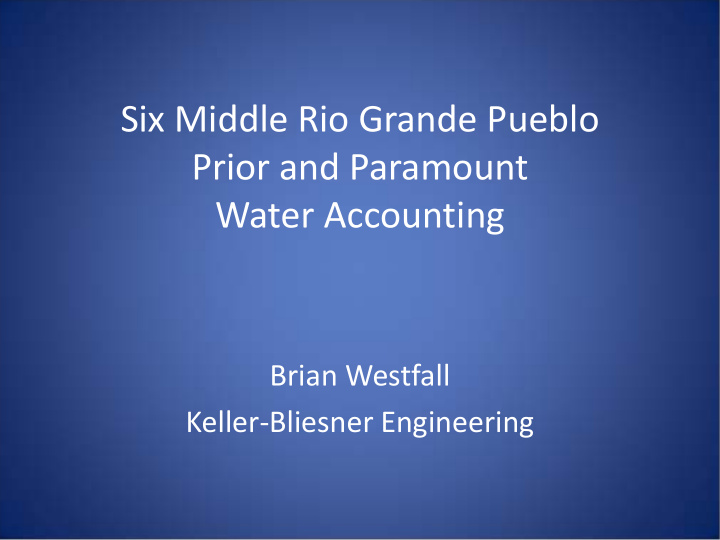



Six Middle Rio Grande Pueblo Prior and Paramount Water Accounting Brian Westfall Keller-Bliesner Engineering
History • Prior to creation of MRGCD in 1923 there were about 70 direct diversions from the Rio Grande within the Middle Rio Grande Valley • MRGCD combined the separate systems from Cochiti Pueblo to Bosque del Apache National Wildlife Refuge so only four diversion dams were required to divert water to MRGCD lands. • To combine systems MRGCD had to incorporate the systems of the Six Middle Rio Grande Pueblos into MRGCD
History • This required Congressional Approval • In 1928 the Secretary of Interior executed an agreement with MRGCD providing for Conservation, Irrigation, Drainage and Flood Control for the Pueblo Indian Lands in the Rio Grande Valley • The 1928 act provided that water rights on 8,346 acres Pueblo lands “shall be prior and paramount to any rights of the district or of any property holder therein”
History • The total P&P lands acreage was later updated to the current 8,847 acres • There has not been much controversy since that time regarding the Pueblos taking natural flow • There has been controversy on applying the Rio Grande Compact to P&P reservoir storage and release in post-Compact reservoirs (El Vado).
1981 El Vado Storage Agreement • Laid out general procedures for storage and release of P&P water • Signatories to this agreement were: • Six Middle Rio Grande Pueblos Irrigation Committee • Bureau of Reclamation • Secretary of Interior Designated Engineer • Bureau of Indian Affairs
Current Procedures • Designated Engineer (DE), Coalition and Bureau of Reclamation meet three times a year in the spring to calculate P&P water to store in El Vado • Storage requirement is based on estimated P&P lands crop water requirements accounting for irrigation and conveyance efficiencies • When P&P demands at Otowi can not be met through natural flow P&P stored water is released from El Vado
Current Procedures • The role of the DE is to determine if a P&P release requested by one of the Pueblos is justified • Unused Indian Storage Account water is typically transferred during the month of November (MRGCD or Elephant Butte)
DE’s Computation Tools • Excel spreadsheets are used in both the storage and release calculations
DE vs. URGWOM • BIA requested that Keller-Bliesner Engineering compare the methods used by the DE to URGWOM methods • Report those differences to BIA and the URGWOM technical committee • Attempt to resolve the differences
What were the Differences?
Storage Calculation • El Vado P&P storage is calculated monthly as follows: (somewhat simplified) – Forecast available “natural flow” at Otowi using procedures in 1981 agreement – Compare the P&P demand to the forecasted flow – if P&P Demand > Available “natural flow” then difference plus the El Vado to Otowi losses is the storage requirement • Difference in P&P Demand
P&P Demand Differences • Pueblo demand at Otowi used in El Vado Storage calculation – URGWOM uses 63,383 ac-ft – BIA uses 83,736 ac-ft This difference has not been resolved
Forecast Flow Factors • 1981 Agreement specified factors to estimate water supply at Otowi from forecasted Flow – March 1 forecast (March to July) multiplied by 0.6 – April 1 forecast (April to July) multiplied by 0.7 – May 1 forecast (May to July) multiplied by 0.8 – URGWOM had used 0.7, 0.8, 0.9 and factors were changed to reflect the DE’s values
Storage Requirement Rule Change • Change made to function: ComputeSupplyAtOtowi Low Record Late Summer Flows + Forecasted RO Volume Remaining * Monthly Spring RO Percentage – Anticipated El Vado Storage
P&P Releases • Determine the P&P demand at Otowi If usable “natural flow” at Otowi < P&P demand then release water from El Vado Indian storage account
Release Rule Changes • URGWOM method relies only on flow at Embudo – any natural flow arriving at Otowi from La Puente would not be seen • DE methods accounts for the La Puente flow • URGWOM method is a simplification that has been discussed and approved by the DE
Other Release Rule Corrections
P&P Demand below Otowi (79,188 vs. 85,534) 350 300 250 200 150 100 50 0 1-Mar 1-Apr 1-May 1-Jun 1-Jul 1-Aug 1-Sep 1-Oct 1-Nov Spreadsheet URGWOM
Questions
Recommend
More recommend